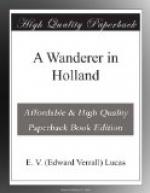The amazingly minute picture of “The Poulterer’s Shop” which hangs in the National Gallery as a pendant to Dou’s work with the same title, is by William van Mieris, the son of Dou’s favourite pupil. He also was born at Leyden, that teeming mother of painters. Frans van Mieris, his father, died at Leyden in 1681; William died at Leyden in 1747.
Above the work of Frans van Mieris I would put that of Gabriel Metsu, another of Dou’s pupils, and also a son of Leyden, where he was born in 1630. Upon Metsu’s work Terburg, however, exercised more influence than did Gerard Dou. “The Music Lesson” and “The Duet” at the National Gallery are good examples of his pleasant painting. Even better is his work at the Wallace Collection. He died in 1667 in Amsterdam, where one of his best pictures “The Breakfast”—No. 1553 at the Ryks—may be seen. There are many fine examples at the Louvre. He was always graceful, always charming, with a favourite model—perhaps his wife—the pleasant plump woman who occurs again and again in his work. She is in “The Breakfast” (see the opposite page).
Mention of Gerard Dou and his pupils reminds me of a little-known satire on art-criticism written by “Vathek” Beckford. Biographical Memoirs of Extraordinary Painters it is called, among the painters being Sucrewasser of Vienna, and Watersouchy of Amsterdam. It is Watersouchy who concerns us, for he was a Dutch figure painter who carried the art of detail farther than it had been carried before. I quote a little from Beckford’s account of this genius, since it helps to bring back a day when the one thing most desired by the English collector was a Dutch picture—still life, boors, cows, ruins, or domestic interior—no matter what subject or how mechanically painted so long as it was done minutely enough.
“Whilst he remained at Amsterdam, young Watersouchy was continually improving, and arrived to such perfection in copying point lace, that Mierhop entreated his father to cultivate these talents, and to place his son under the patronage of Gerard Dow, ever renowned for the exquisite finish of his pieces. Old Watersouchy stared at the proposal, and solemnly asked his wife, to whose opinion he always paid a deference, whether painting was a genteel profession for their son. Mierhop, who overheard their conversation, smiled disdainfully at the question, and Madam Watersouchy answered, that she believed it was one of your liberal arts. In few words, the father was persuaded, and Gerard Dow, then resident at Leyden, prevailed upon to receive the son as a disciple.




